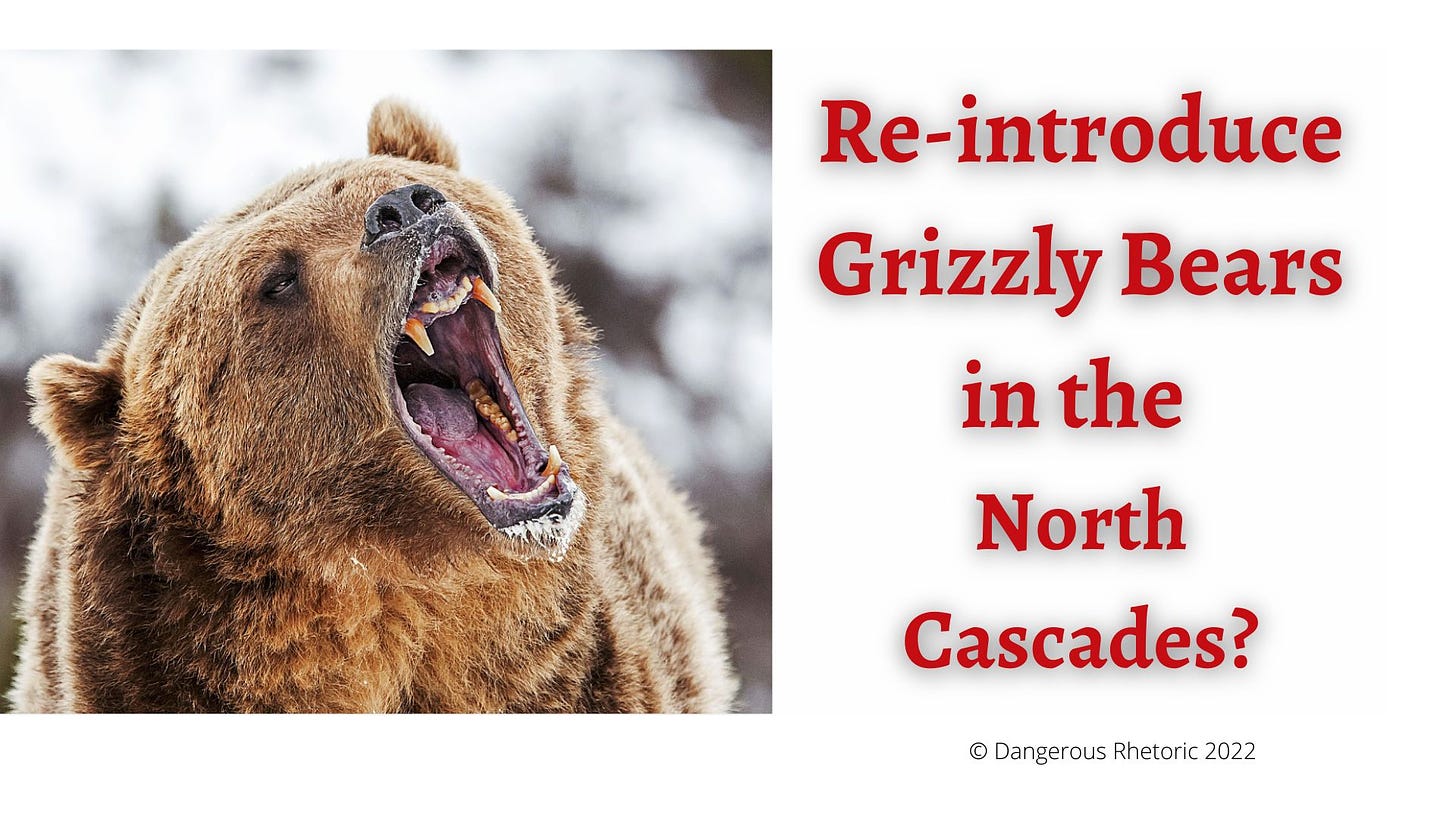A group of unelected bureaucrats from the National Park Service and U.S. Fish and Wildlife Service think it would an awesome idea to “re-introduce” Grizzly Bears into the North Cascades region of Washington State.
These bureaucrats have opened an Environmental Impact Study (EIS) to “evaluate options for restoring and managing grizzly bears in the North Cascades of Washington…”.
Many citizens of north central Washington think this is a really bad idea. In 2018-19 citizens of the region fought hard to convince the agencies to choose a “take no action” plan on this idea. At the time, they were successful. Now, they are going to have to fight this battle again.
If you have concerns about the wisdom of the plan to import 200+ grizzly bears into the North Cascades, my purpose today is to call you into action, and provide you with the information you need to take effective action. If you are as concerned about this plan as I am, please take the time to understand the issues, study the arguments of the proponents, provide inputs and build positive relationships with the decision makers involved.
Ursus Arctos Horribilis
Consider the grizzly bear, also known as Ursus arctos horribilis. These animals are omnivorous apex predators. “Apex” means dangerous to every other creature in the ecosystem—including people. Grizzly Bears are huge in size, very fast, territorial and they will eat anything—dead or alive. The project experts claim grizzlies are shy, mostly-vegetarian carrion eaters, and important to the ecosystem because they are “great diggers”.
The agencies involved in the effort make several claims about the bears that are not well documented. First, they claim grizzly bears once “thrived” in the Cascade Mountains. I’m not sure that the data show “thriving” populations rather than a smaller somewhat transient population. I’m skeptical the ecosystem in its current state will provide enough food for the 200 animals that they hope to import.
Also, area hunters tell me that we don’t need to “reintroduce” the grizzly bear—they’re already here in Eastern Washington. It would make much more sense to let nature take its course and allow the grizzly bears to continue a more gradual and natural recovery rather than try to force the issue by importing lots of new animals into communities that don’t want to be overrun by hungry bears.
Who’s involved?
The Interagency Grizzly Bear Committee is the key group promoting grizzly bear reintroduction. Their mission is to reintroduce grizzly bears into targeted areas of the western United States. Achieving the mission overrides all other considerations. They don’t appear to care whether or not community members in the target areas want hundreds of dangerous apex predators imported right into their back yards.
They think providing education about avoiding bears is an adequate solution to the inevitable problems that comes from having bears and people sharing the same ecosystem.
What’s the process involved with the Environmental Impact Study?
The EIS process is intended to identify a range of alternatives for restoring the bears to the Cascade region in order to support the recovery and eventual delisting of grizzly bears under the Endangered Species Act in the contiguous United States.
Unfortunately, Eastern Washington communities are already suffering from the introduction of another endangered apex predator: the wolf. In communities which have growing wolf populations, the citizens have very little ability to protect their livestock, pets or family members when these endangered animals come to the neighborhood. Bureaucrats from out of town make local residents jump through many hoops before problem animals can be removed.
Why would Washington residents agree to importing a second, even more dangerous wild animal in the region? We have very little faith in the promises made by out-of-town bureaucrats who put the needs of wildlife ahead of the safety and welfare of residents.
The Grizzly Bear Environmental Impact Study is currently open for comments. We have until Dec. 14 to gather information and make a comment on the plan. For information, visit the National Parks Service landing page on the Grizzly Bear Restoration Plan.
You’ll find meeting dates and meeting links. Please try to attend one of the last two scoping meetings. You’ll also find the scoping documents. Please download these documents and do your own research about this proposal.
Next year sometime, the Interagency Grizzly Bear Committee will present multiple options about how to best proceed with the proposed bear reintroduction. To have input on these options, please submit your comments before Dec. 14 with your concerns. Ask the committee to support a “Take No Action” option.
Let’s let nature take its course and allow the grizzly bears to continue to recover naturally and gradually to a population level that the ecosystem will naturally support.
Nancy Churchill is a writer and marketing consultant in rural eastern Washington State, and the state committeewoman for the Ferry County Republican Party. She may be reached at DangerousRhetoric@pm.me. The opinions expressed in Dangerous Rhetoric are her own.




